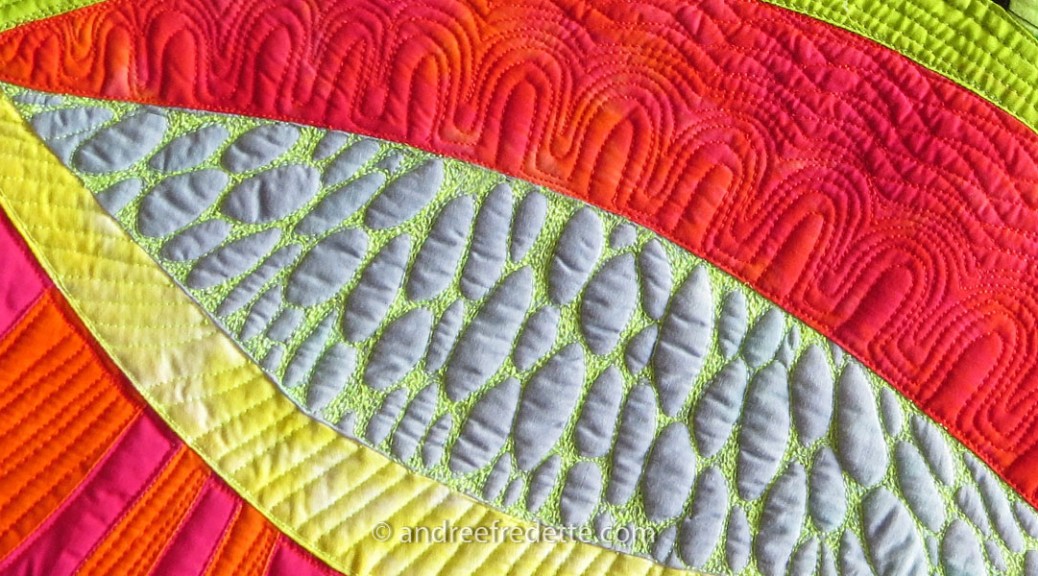Continuing with the series (my previous Quilt and Stitch posts: One, Two, Three, Four, Five, Six and Seven).
Here is a look at Jungle, a quilt I made two years ago. I like to think of my motifs as “graffiti” quilting, because they flow out of my brain without too much thought and planning. I don’t do a lot of marking ahead of time. If any.
It is obvious that I get my ideas from the green world out there, and the bubbles are a form of cells. Above, I began by outlining the bubbles with a first go-round. Then – as shown on the featured photo at the top of this post – I “really put some thread into it”, to make the blue fabric bubbles really stand out from all the contrasting stitching.
 Putting a lot of thread work in some bits, next to loosely quilted areas, can create issues. The piece will not lie flat. Since I consider my work to be two-dimensional, I have to solve that problem. Above, one solution is to create a “dart”. Breathe deeply and… cut. Then sew again, and re-stitch the affected area. Works like a charm. It is just a bit scary the first time you attempt it…
Putting a lot of thread work in some bits, next to loosely quilted areas, can create issues. The piece will not lie flat. Since I consider my work to be two-dimensional, I have to solve that problem. Above, one solution is to create a “dart”. Breathe deeply and… cut. Then sew again, and re-stitch the affected area. Works like a charm. It is just a bit scary the first time you attempt it…
This is an exuberant quilt, with wild colours. So is nature, by the way… Below, an example from my deck, a succulent (forgot the name) that spends the summer outside, in the sun. In winter, this plant is green, mostly. But right now, it is very happy in the sun:
Back to the quilting. Deciding on a texturing approach for different areas of the quilt is tricky. Sometimes, I go with straight lines, sometimes, curvy-curly. Here are two “neighbourhoods” with contrasting solutions:
And as an afterthought, I added some thick and exxagerated stitching lines on the right, to echo the pieced ridges on the left.
Another quilting idea comes from “pointy bits”, a tree I noticed at the Butchart Gardens. Here is a close-up photo:
Pointy Bits served as inspiration for the pointy quilting lines below. As usual, I did not try to concoct an exact representation of that leaf pattern. That pattern was just a starting point for me.
Continuing with other areas of the piece, there were more leaf areas to texture, so I chose the obvious, wavy lines that evoke leaf veins…
There are soooo many ways to interpret leaf lines. As many as there are leaves, really. Here is a manipulated photo of hostas, in their full glory:
 Aren’t they just luscious? Summer’s late afternoon sunshine, reaching for these shade-loving plants. They are basking in the light. Those lines are lovely…
Aren’t they just luscious? Summer’s late afternoon sunshine, reaching for these shade-loving plants. They are basking in the light. Those lines are lovely…
And here, in another section of the same quilt, a motif that has been following me around for at least a decade: the leaf, shield, whatever it suggests to you… Surrounded by repeat lines, and straight ones that wander.
And as a finish, here is close-up photo of crocosmia blooms, with a touch of digital manipulation. I just wanted to finish on a note of orange…




































